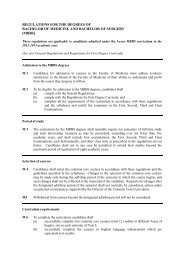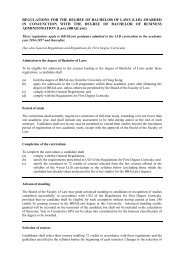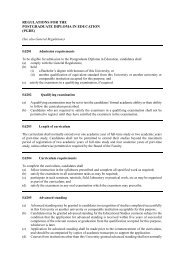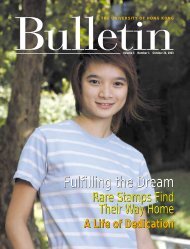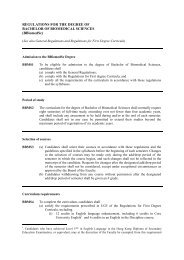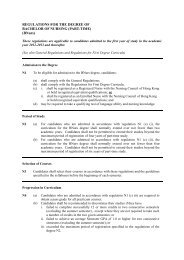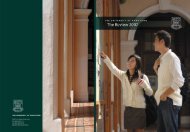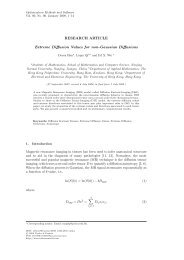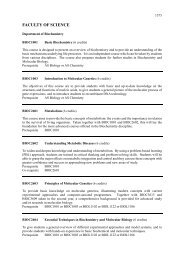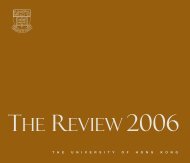Bachelor of Arts (BA) - The University of Hong Kong
Bachelor of Arts (BA) - The University of Hong Kong
Bachelor of Arts (BA) - The University of Hong Kong
You also want an ePaper? Increase the reach of your titles
YUMPU automatically turns print PDFs into web optimized ePapers that Google loves.
120CLIT2022.Reading the nineteenth-century: reaction and modernity (6 credits)This is the second <strong>of</strong> two courses reading texts from the nineteenth-century. Fastening on the three'masters <strong>of</strong> suspicion' in the nineteenth-century - Marx, Nietzsche, Freud - it reads the triumph <strong>of</strong>realism and <strong>of</strong> bourgeois culture, and examines ways in which this culture was critiqued. Teaching willlook at literary texts drawn from European cultures - Russia, France, Germany, Britain, and America.CLIT2023.Heterologies: the discourse <strong>of</strong> the other (6 credits)'Heterology' is 'the science <strong>of</strong> what is completely other'. It, and the course, looks at a range <strong>of</strong> ways inwhich the 'other' appears in literary texts - as the colonial savage, as mad, as mystic, as criminal, assexually deviant, or in relation to fascism.CLIT2024.Reading comedy: Dante and Boccaccio (6 credits)<strong>The</strong>re are two texts derived from the Italian Renaissance to be used for this course: Dante's Comedy,which divides into three - Inferno, Purgatory and Paradise, and Boccaccio's Decameron. <strong>The</strong>se arecrucially important and formative texts, the second a response to the first, which deserve re-readingboth in order to confront texts <strong>of</strong> the past, and in the light <strong>of</strong> contemporary theoretical approaches fromnew historicism, from feminism, from work on the body and on sexuality and the city. We will examinethe new forms <strong>of</strong> narrative that emerged with the urban and bourgeois culture <strong>of</strong> fourteenth-centuryFlorence, with its new attention to the subject as individual and as communal. Above all, we will beconsidering what is meant by 'comedy' and why both Dante and Boccaccio work within its terms.CLIT2025.Visual cultures (6 credits)(This course is also <strong>of</strong>fered to second and third year non-<strong>BA</strong> students for inter-Faculty broadeningpurposes.)It has <strong>of</strong>ten been said that ours is pre-eminently a culture <strong>of</strong> the visual, a 'Society <strong>of</strong> the Spectacle'. Thiscourse introduces students to one <strong>of</strong> the key developments in cultural theory today: a study <strong>of</strong> howvisual cultures are formed, and how they inform the ways we see, feel and think. <strong>The</strong>re is indeed 'anoptical unconscious' made up <strong>of</strong> the criss-crossings <strong>of</strong> desire, ideology and reproductive technologies(or Freud, Marx and SONY), which manifests itself from ephemeral fashions to the permanencies <strong>of</strong>architecture. What the course will focus on, however, are specific examples <strong>of</strong> changes and innovationsin visual culture found in art, photography, cinema, architecture, video, and urban life; and in particular,all the examples <strong>of</strong> visual material that problematize visuality. We will also attempt to draw out theimplications <strong>of</strong> such problematic visualities for critical and cultural theory.CLIT2026.Digital culture and new media technologies I (6 credits)(This course is also <strong>of</strong>fered to second and third year non-<strong>BA</strong> students for inter-Faculty broadeningpurposes.)This course examines the interactions between contemporary critical and cultural theory and digitalculture. We will discuss theoretical and compositional approaches in the work <strong>of</strong> international newmedia artists (via World Wide Web, CD-ROM, video, exhibition and slide formats as available), andcreate new media projects ourselves, in order to expose possible modes <strong>of</strong> critical interpretation andcreation for these media. Issues <strong>of</strong> identity construction, gender, corporeal vs. psychic presence,interactivity, bodily motion and motion capture, community, interface, performativity, andrepresentation will be addressed.



